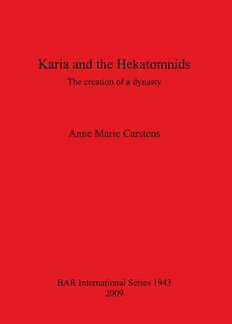
Karia and the Hekatomnids: The creation of a dynasty PDF
169 Pages·2009·73.622 MB·English
Most books are stored in the elastic cloud where traffic is expensive. For this reason, we have a limit on daily download.
Preview Karia and the Hekatomnids: The creation of a dynasty
Description:
On the specific level, this work is an enquiry into Karia (south-western Turkey) and the Hekatomnids in the 4th century BC, a Persian satrapy and its political strategies expressed in its state monuments. On the general level, this is a study of divine kingship, on the creation of a national or shared identity, on acculturation and colonialism: thereby also on globalization. The result may be characterized as an ethnological dissertation on a topic of ancient history elucidated through archaeological analyses. The monograph examines how the Hekatomnids created a successful and prosperous dynasty, providing a lesson on how to enact, stage, and maintain power, by an active use of style and cultural affiliations. It is a study of the formation of an iconography of royal ideology (in its broadest sense) in the Hekatomnid dynasty of the 4th century BC, exploring the nature of power, ethnicity, and acculturation. Above all, the study narrates the story from the perspective of Karia as Karian – a landscape and people like other landscapes and peoples formed by its geographical, geopolitical, and cultural position.
See more
The list of books you might like
Most books are stored in the elastic cloud where traffic is expensive. For this reason, we have a limit on daily download.
